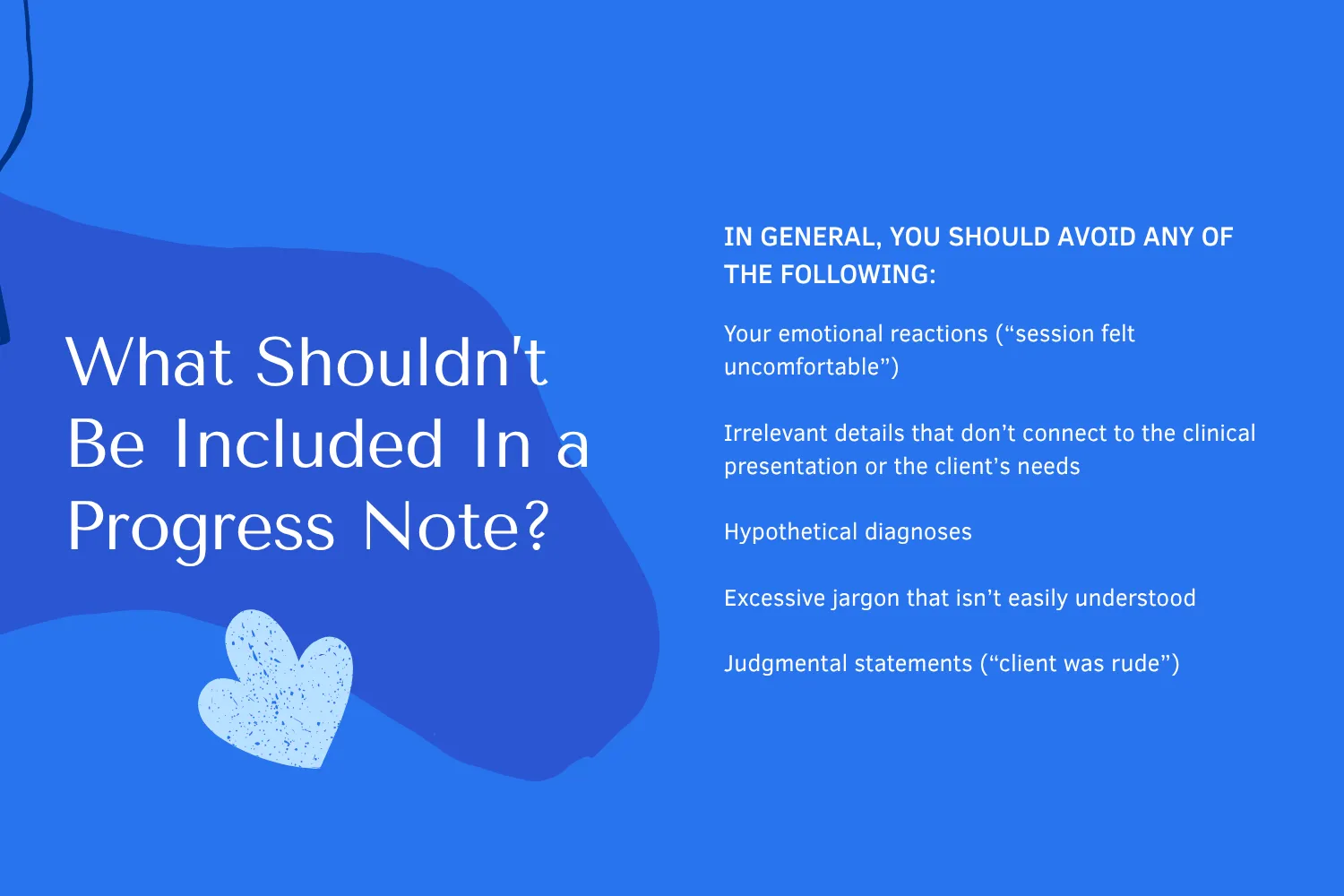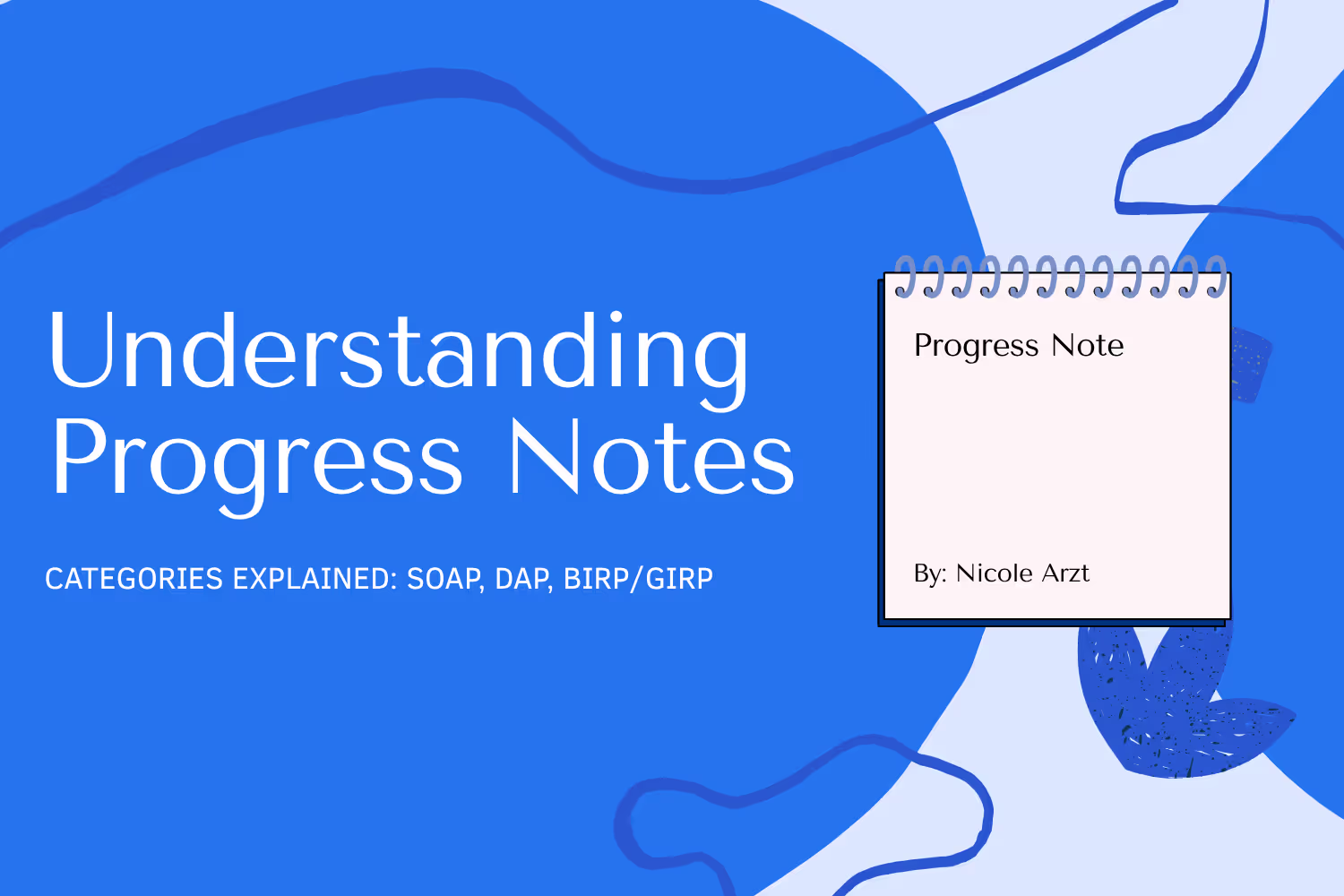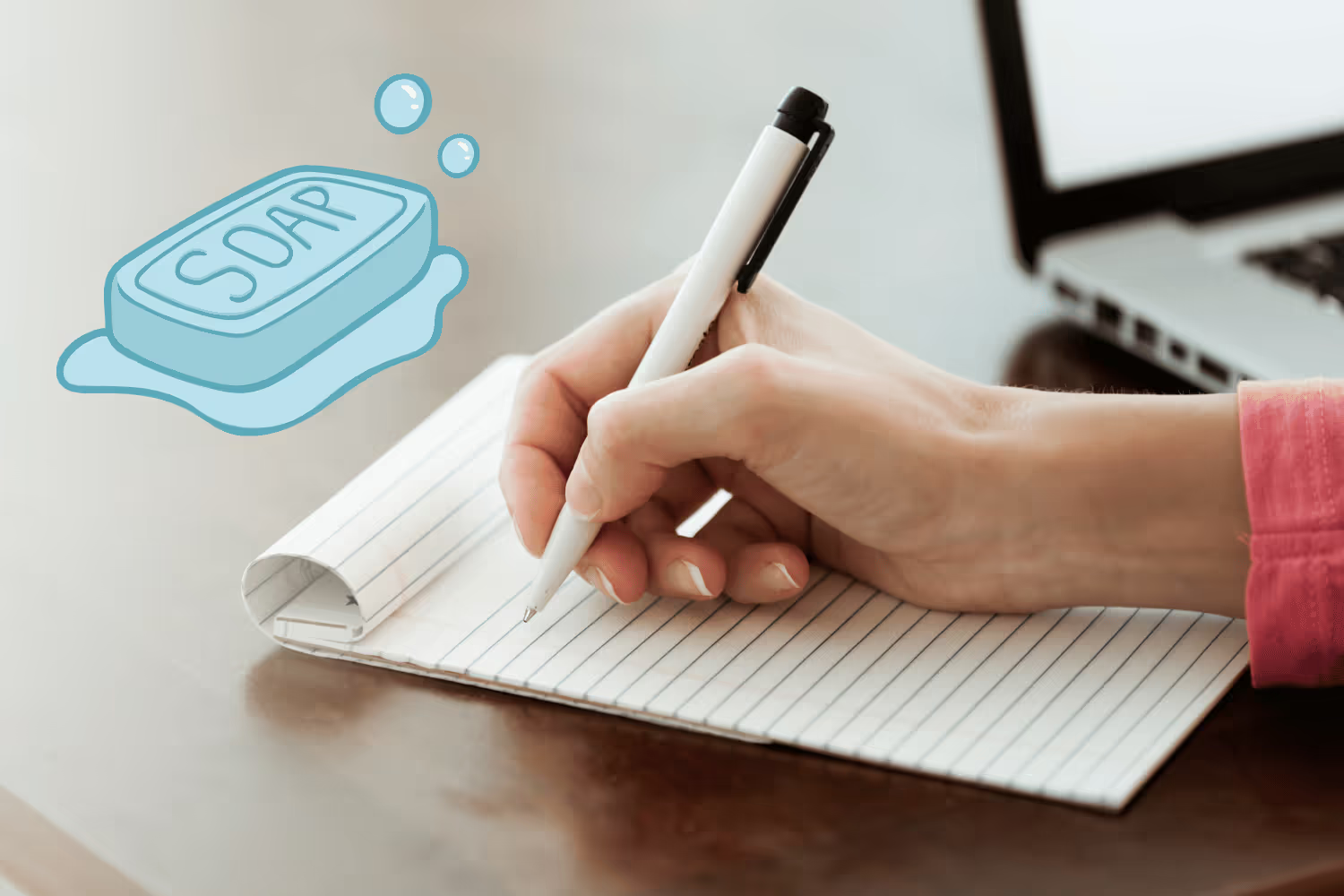Therapists know that notes are the dreaded ‘necessary evil’ in this profession, but learning how to write them efficiently and effectively can help you feel less overwhelmed. Good documentation is important for many reasons, including honoring compliance, tracking treatment goals and progress, and maintaining necessary client care.
Unfortunately, most clinicians get little to no paperwork training. As a result, many end up writing way too much or way too little, resulting in subpar documentation. Therapists can also fall into cycles of procrastinating on notes, reinforcing more anxiety and agitation. In this guide, I’ll review the basic standards for clinical documentation and offer my best tips for writing your notes comprehensively.
An Overview of Progress Notes
A progress note offers both an objective and subjective summary of each client interaction. These notes chronologically monitor progress and provide insight into interventions, observations, diagnostic data, and treatment recommendations.
Progress notes become part of a client’s official medical record. While they are held confidentially, they can be accessed by authorized personnel with a release of information. If your client uses insurance for treatment, the insurance company can audit notes at any time. Subsequently, notes may be mandated by a court order if your client is involved in a legal issue. Finally, clients also have the right to access their notes if desired.

Continuity of care: Progress notes help you keep track of your overall treatment. It’s a good practice to refer to notes just before a session to review content from previous sessions. This maintains a continuity of care.
Insurance billing and requirements: Insurance companies authorize therapy when they deem that services meet medical necessity. Progress notes, therefore, should accurately reflect overall treatment plans. Failure to complete paperwork can result in claim denials or insurance clawbacks.
Transparency of services: In recent years, there has been more of a push for clients to collaborate and engage with their services directly. Some agencies now require collaborative documentation where you and the client complete documentation together. This can foster a sense of client empowerment, helping them feel more connected to their treatment.
Legal and ethical considerations: Although individual state laws differ, most licensing boards require therapists to maintain progress notes to adhere to the laws and ethics of their field. This is important for liability, particularly in higher-risk situations, including when clients are suicidal or need additional crisis support.
Common Types of Progress Notes
Therapists can use different standardized templates for their documentation. If you work for an agency, they probably establish the standards for paperwork. If you have your own practice, you’re responsible for ensuring that your notes are done efficiently and appropriately.
SOAP Notes
SOAP stands for subjective, objective, assessment, and plan.
Subjective: This section includes any of the client’s indicated feelings, needs, symptoms, and experiences. It’s a good practice to get in the habit of jotting down direct statements from the client in this space.
“Client reported, ‘I have been feeling more tired than usual lately. I’m not sure why, though.”
Objective: This section captures concrete and measurable information about what occurred during the session, including comments about physical appearance, symptom progression, specific observations, and reactions to interventions. Only stick to the facts and aim to provide a neutral description of what you notice.
“Client presented as fatigued during this session, yawning frequently during this interaction. He spoke more slowly than usual.”
Assessment: The assessment section blends data from the subjective and objective sections to offer a clinical overview.
“Client appears to be continuously struggling with symptoms of depression, including fatigue and poor motivation. He is struggling to implement coping strategies and reports persistent tiredness despite practicing good sleep hygiene.”
Plan: The plan details future interventions or goals to be considered in subsequent sessions. It may also include other referrals or homework assignments.
“Therapist and client will continue to focus on identifying cognitive distortions related to energy and motivation. Client agreed to track daily activities and energy levels using a mood journal. Therapist will also assess potential need for psychiatric referral if symptoms do not improve over the next month.”
DAP Notes
DAP stands for data, assessment, and plan.
Data: This section includes any factual observations or information that occurred during the session. Include any details about the client’s mental status, physical appearance, current symptoms, and interventions utilized during the session.
“Client arrived five minutes late to session, stating that there was a “lot of traffic coming here.” She stated that the week was “good” and acknowledged having a positive interaction with her mother a few nights ago. Client and therapist engaged in cognitive restructuring techniques, focusing on identifying and challenging negative thoughts related to her self-esteem. Client presented as engaged and motivated throughout the session and seemed receptive to this intervention.”
Assessment: This section synthesizes measurable data with the therapist’s observations and clinical overview about the case. You should note how you perceive treatment is progressing and how certain symptoms are either improving or worsening.
“Client is exhibiting improvements in emotional regulation and demonstrating increased awareness of her cognitive patterns. Improving her relationship with her mother appears connected to mood stability. There are no indications of crisis or safety concerns at this time. Treatment goals will continue to focus on improving interpersonal relationships and strengthening self-esteem.”
Plan: The plan outlines future steps for treatment, including the next session date, referrals to other providers, homework assignments, and any additional considerations.
“Client and therapist will meet for the next individual session on May 10, 2025, at 10:00 am. They will explore strategies for managing her upcoming family trip and continue processing struggles related to self-esteem.”
BIRP/GIRP
BIRP stands for behavior, intervention, response, and plan. GIRP is similar enough to BIRP except the ‘g’ stands for goal.
Behavior: This section includes the client’s behaviors specific to that session. You should include what you specifically see, hear, and observe, including noteworthy changes in affect, physical appearance, and various verbal cues.
“Client presented as anxious and somewhat uncomfortable during the session, frequently diverting eye contact and squirming in his seat. He acknowledged feeling “nervous” about meeting for therapy today, stating that he was feeling “ashamed” about his struggles with his wife. Client’s speech was somewhat hesitant and fragmented when discussing more sensitive topics.”
Goal: If using a GIRP template, the ‘g’ refers to the central focus of your session. Indicate the particular treatment goal that connects to the client’s original treatment plan. This should be both measurable and specific.
“Goal addressed: Client will increase emotional regulation and decrease impulsive behavior by cultivating insight into unconscious relational patterns and internal conflicts. Cultivate awareness into early attachment wounds affecting current behavioral patterns.”
Intervention: This section includes the clinical techniques and interventions applied during the session. You should use language specific to your therapeutic modality and describe why these interventions were executed.
“Therapist used supportive psychodynamic interventions to further explore the client’s underlying feelings of anxiety and shame. Therapist commented on how the client’s discomfort may connect to deeper fears of criticism and rejection, potentially rooted in early familial relationships and in his marital dynamic with his wife. Therapist maintained a non-judgmental presence to cultivate a corrective emotional experience.”
Response: This section focuses on how the client reacted to your interventions. It can include both verbal and nonverbal responses.
“Client initially presented as withdrawn when the therapist discussed his discomfort, responding with more guarded answers. As the session progressed, he became more reflective, stating, “Yes, I often feel nervous when people pay attention to my needs.” His affect also shifted, and he was able to articulate how the shame he experienced with his wife reminded him of shame he felt with his father and older brother.”
Plan: As mentioned with the above templates, the plan identifies the next steps for therapy.
“Therapist and client will continue exploring core relational patterns, focusing more specifically on defenses against shame. Therapist will identify potential transference reactions and continue strengthening the therapeutic relationship. Therapist and client will meet for the next session on May 20, 2025.”
FAQ About Clinical Documentation

How Quickly Should You Complete Progress Notes?
Ideally, you should complete progress notes on the same day as the session. However, life gets hectic, and in busy settings, it’s generally considered acceptable to finalize notes within 24–48 hours. Do your best to avoid delaying more than 72 hours. By this time, your memory of the session will fade, increasing the risk of jotting down inaccuracies. Furthermore, you may run into issues with insurance requirements or agency policies regarding timely documentation.
How Long Should It Take to Write a Progress Note?
This depends. It’s common for newer clinicians to spend more time on paperwork than experienced ones. It should take between 5-10 minutes to write a note. Templates, session complexity, and agency documentation standards can all affect timeliness.
What Shouldn’t Be Included In a Progress Note?
In general, you should avoid any of the following:
- Your emotional reactions (“session felt uncomfortable”)
- Irrelevant details that don’t connect to the clinical presentation or the client’s needs
- Hypothetical diagnoses
- Excessive jargon that isn’t easily understood
- Judgmental statements (“client was rude”)
What If You’re Extremely Behind on Notes?
It happens to everyone. However, if you’re behind, it’s important to solidify a plan to catch up. Aim to prioritize high-risk sessions first. A ‘high-risk’ session entails anything that could compromise a client’s safety, including suicidal or self-harm concerns or a significant escalation in mental health symptoms, such as substance use, psychosis, or disordered eating.
What’s the Difference Between Progress Notes and Psychotherapy Notes?
Progress notes become part of an official medical record and can be audited by insurance companies and judges. You should always write these notes with the consideration that they could be potentially accessed. Psychotherapy notes, on the other hand, refer to your own internal reflections. These are kept separately and can be written for yourself.
Should You Allow Clients Access to Their Notes?
HIPAA guidelines generally permit clients to have legal rights to access their progress notes. If you’re concerned about how your client might perceive their documentation, you can, in some cases, deny the request. However, you must offer a written explanation detailing the denial. You may also offer a treatment summary overviewing your course of care.
Do All Sessions Need to Be Documented?
Yes, you must indicate whether each session was attended, canceled, no-showed, or rescheduled. All client contact should be documented, including phone calls and email exchanges.
How Much Detail is Actually Sufficient?
This is subjective, but notes must typically include objective information about what occurred during the session. This includes both your interventions and the client’s responses to them. Ideally, another clinician should be able to read your documentation and comprehend the session even if they have never met the client.
Keep in mind you are not transcribing sessions or sharing all parts of the appointment verbatim. Excessive detail can actually breach sensitive information and detract from the most important parts of the session.
How Do You Document High-Risk Concerns Like Suicide or Abuse?
Always describe what the client discloses and your own risk assessment process. Clearly articulate which interventions you used, including safety plans, mandated reports, or discussions about hospitalizations. Note any outside consultations you engaged in regarding the case.
What Are the Differences Between Objective and Subjective Information?
Subjective information refers to what the client shares within the session. For example, you might write, “Client indicates feeling more frustrated this past week”). Objective information refers to your own observations and reflections. For example, you could indicate, “Client presented as agitated in the session, speaking with a more pressured speech and animated tone”).
What Needs to Be Considered for Telehealth Documentation?
When documenting telehealth sessions, indicate that the session occurred virtually and describe when and where the session was conducted. If technical difficulties emerge, make a note of them.
Session was conducted via the therapist’s secure HIPAA-compliant telehealth EMR. Client was located in Los Angeles, CA. There were no technical issues to note during this time.
How Much Jargon Should You Include in Notes?
Clinical terminology is appropriate, but excessive jargon may be confusing or misleading. When in doubt, consider whether another clinician who doesn’t know your client could interpret your notes without needing to look any terms up.








